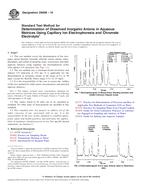Potrebujeme váš súhlas na využitie jednotlivých dát, aby sa vám okrem iného mohli ukazovať informácie týkajúce sa vašich záujmov. Súhlas udelíte kliknutím na tlačidlo „OK“.
ASTM D6508-10
Standard Test Method for Determination of Dissolved Inorganic Anions in Aqueous Matrices Using Capillary Ion Electrophoresis and Chromate Electrolyte
Automaticky preložený názov:
Štandardná skúšobná metóda pre stanovenie rozpustených anorganických aniónov vo vodných matríc kapilárnej elektroforézy Ion a Chromate elektrolyt
NORMA vydaná dňa 1.9.2010
Informácie o norme:
Označenie normy: ASTM D6508-10
Poznámka: NEPLATNÁ
Dátum vydania normy: 1.9.2010
Kód tovaru: NS-35424
Počet strán: 17
Približná hmotnosť: 51 g (0.11 libier)
Krajina: Americká technická norma
Kategória: Technické normy ASTM
Anotácia textu normy ASTM D6508-10 :
Keywords:
anion, capillary electrophoresis, drinking water, ion analysis, reagent water, substitute wastewater, wastewater, Substitute wastewater, Sulfate (ion) analysis, Wastewater testing/treatment, Anions content, Bromide (ion) analysis, Capillary ion electrophoresis (CIE), Chloride analysis, Drinking water, Fluoride (ion) analysis, Inorganic anions, Inorganic chemical analysis--water, Nitrate (ion) analysis, Orthophosphate content, Phosphate (ion) analysis, Reagent water
Doplňujúce informácie
| Significance and Use | ||||||||||||||||||||
|
Capillary ion electrophoresis provides a simultaneous separation and determination of several inorganic anions using nanolitres of sample in a single injection. All anions present in the sample matrix will be visualized yielding an anionic profile of the sample. Analysis time is less than 5 minutes with sufficient sensitivity for drinking water and wastewater applications. Time between samplings is less than seven minutes allowing for high sample throughput. Minimal sample preparation is necessary for drinking water and wastewater matrices. Typically, only a dilution with water is needed. This test method is intended as an alternative to other multi-analyte methods and various wet chemistries for the determination of inorganic anions in water and wastewater. Compared to other multi-analyte methods the major benefits of CIE are speed of analysis, simplicity, and reduced reagent consumption and operating costs. |
||||||||||||||||||||
| 1. Scope | ||||||||||||||||||||
|
1.1 This test method covers the determination of the inorganic anions fluoride, bromide, chloride, nitrite, nitrate, ortho-phosphate, and sulfate in drinking water, wastewater, and other aqueous matrices using capillary ion electrophoresis (CIE) with indirect UV detection. See Figs. 1-6. 1.2 The test method uses a chromate-based electrolyte and indirect UV detection at 254 nm. It is applicable for the determination or inorganic anions in the range of 0.1 to 50 mg/L except for fluoride whose range is 0.1 to 25 mg/L. 1.3 It is the responsibility of the user to ensure the validity of this test method for other anion concentrations and untested aqueous matrices. Note 1—The highest accepted anion concentration submitted for precision and bias extend the anion concentration range for the following anions: Chloride to 93 mg/L, Sulfate to 90 mg/L, Nitrate to 72 mg/L, and ortho-phosphate to 58 mg/L. 1.4 The values stated in SI units are to be regarded as standard. No other units of measurement are included in this standard. 1.5 This standard does not purport to address all of the safety concerns, if any, associated with its use. It is the responsibility of the user of this standard to establish appropriate safety and health practices and determine the applicability of regulatory limitations prior to use. |
||||||||||||||||||||
| 2. Referenced Documents | ||||||||||||||||||||
|
Odporúčame:
Aktualizácia technických noriem
Chcete mať istotu, že používate len platné technické normy?
Ponúkame Vám riešenie, ktoré Vám zaistí mesačný prehľad o aktuálnosti noriem, ktoré používate.
Chcete vedieť viac informácií ? Pozrite sa na túto stránku.




 Cookies
Cookies
